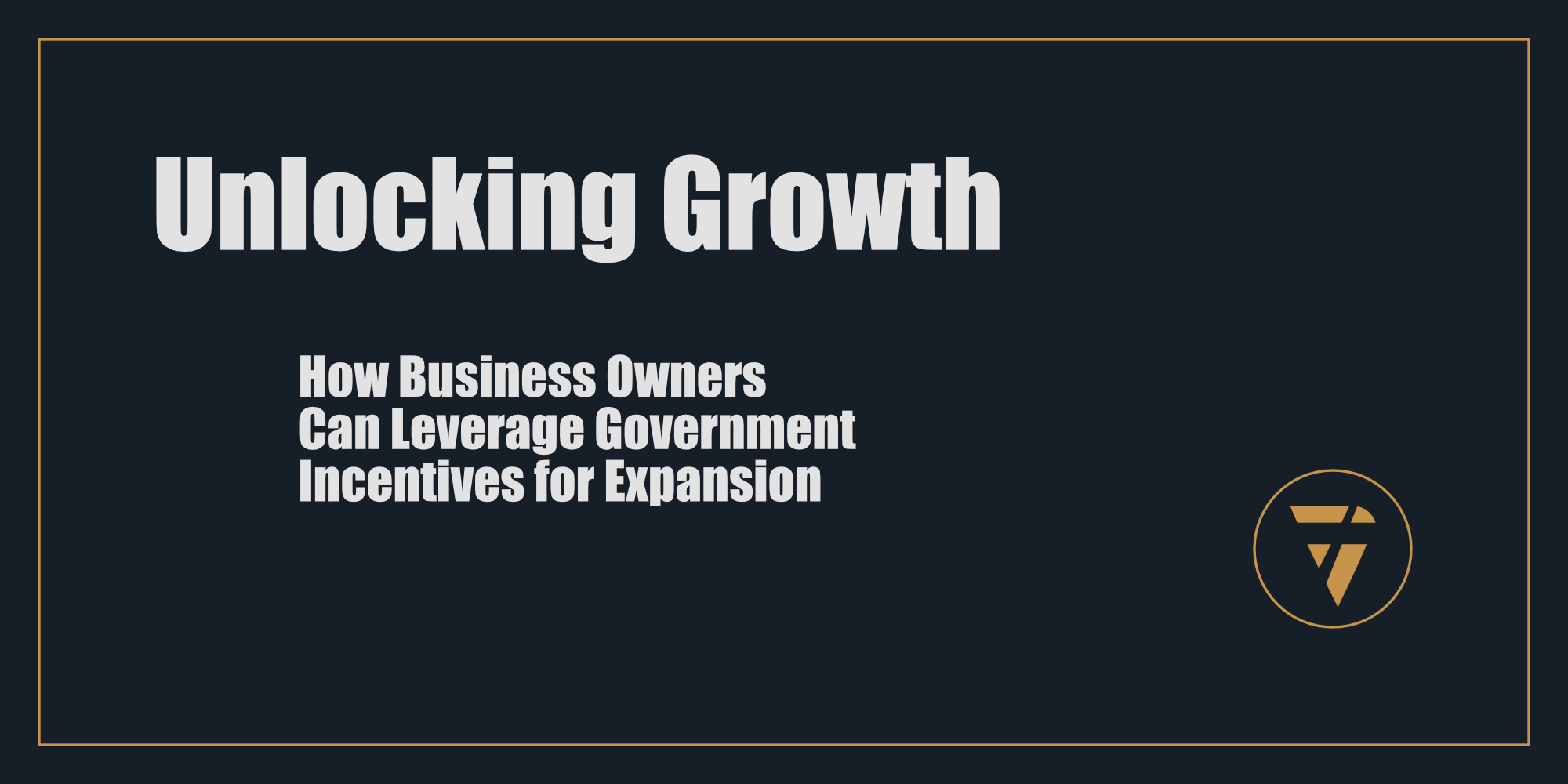Unlocking Growth

How Business Owners Can Leverage Government Incentives for Expansion
Canada’s small and mid-sized enterprises (SMEs) are the backbone of the economy, driving job creation, innovation, and industrial expansion. Yet, many business owners struggle to scale due to a lack of accessible funding, competitive disadvantages in global markets, and slow adoption of advanced technologies.
While policymakers often highlight the availability of government incentives—investment tax credits, automation grants, and R&D funding—many businesses fail to capitalize on these opportunities. The reasons vary: bureaucratic complexity, lack of awareness, and the misconception that such programs are designed only for large corporations.
The truth is, government funding can be a game-changer for small and mid-sized businesses—if used effectively. With the right strategy, businesses can access capital to invest in automation, scale production, expand their workforce, and develop new innovations that allow them to compete on a global scale.
This guide breaks down the most impactful government incentives available to Canadian businesses, how to apply for them, and how to integrate them into a long-term growth strategy.
Investment Tax Credits: Supercharging Business Growth
Investment tax credits (ITCs) offer businesses a direct reduction in taxable income when they invest in productivity-enhancing assets like machinery, software, and infrastructure upgrades. These incentives are particularly valuable for businesses looking to modernize operations without taking on excessive debt.
Key Investment Tax Credit Programs in Canada
- Accelerated Investment Incentive (AII)
- Allows businesses to write off a greater portion of new equipment and technology investments in the year of purchase, reducing taxable income significantly.
- Designed to encourage capital investments in automation, manufacturing, and digital transformation.
- Who should use it? Manufacturers, tech companies, and industrial firms upgrading machinery or software.
- Clean Technology Investment Tax Credit
- Offers up to 30% in refundable tax credits for investments in clean technology, including solar panels, battery storage, and electric industrial equipment.
- Who should use it? Businesses looking to transition toward sustainability while lowering energy costs.
- Regional Investment Tax Credits
- Some provinces, such as Ontario, Quebec, and British Columbia, offer additional tax credits for businesses investing in rural or economically developing regions.
- Who should use it? Businesses expanding into underserved markets or launching regional operations.
How to Access These Credits
- Work with an accountant specializing in tax incentives to integrate ITCs into financial planning.
- Ensure documentation of purchases and investment justification to qualify for the maximum benefits.
- Time investments strategically—many credits increase during periods of economic stimulus.
Automation Grants: Future-Proofing Canadian Businesses
Automation is no longer a luxury—it is a necessity for businesses looking to increase efficiency, reduce costs, and stay competitive. However, the upfront costs of robotics, AI-driven software, and automated manufacturing systems can be prohibitive for SMEs.
Fortunately, government grants and funding programs exist to offset these costs, allowing businesses to invest in automation without straining cash flow.
Top Automation Grants Available in Canada
- Canadian Digital Adoption Program (CDAP) – Boost Your Business Technology Grant
- Provides up to $15,000 in funding for businesses to adopt e-commerce, CRM, and automation technologies.
- Who should use it? Retailers, service providers, and SMEs looking to streamline operations and scale sales channels.
- Canada Industrial Automation Program
- Covers up to 50% of costs for purchasing and integrating industrial automation technology, including robotics and AI-driven logistics systems.
- Who should use it? Manufacturers, logistics firms, and production companies modernizing supply chains.
- Provincial Manufacturing and Automation Grants
- Ontario’s Advanced Manufacturing and Innovation Competitiveness Program offers grants and loans for factory automation and process optimization.
- Quebec’s ESSOR Program supports digital transformation and smart factory investments.
- British Columbia provides funding for AI and machine learning adoption in industrial sectors.
How to Apply for Automation Grants
- Clearly define the ROI of automation investments—programs favour businesses that show productivity gains and job growth potential.
- Consult with a business development specialist to identify which funding program aligns with industry needs.
- Apply early—grant budgets are often limited and awarded on a first-come, first-served basis.
R&D Funding: Turning Innovation into Profit
Canada offers some of the world’s most generous R&D incentives, but many businesses fail to take advantage due to complexity in the application process. R&D funding can help businesses develop new products, improve manufacturing techniques, and drive commercialization efforts.
Key R&D Funding Programs
- Scientific Research and Experimental Development (SR&ED) Tax Incentive
- Canada’s largest innovation tax credit program, offering up to 35% in refundable tax credits on eligible R&D expenditures.
- Covers wages, materials, overhead, and prototyping costs.
- Who should use it? Tech startups, product developers, and manufacturing firms engaged in product improvement.
- Industrial Research Assistance Program (IRAP)
- Provides direct funding and advisory services for small businesses developing new technologies or innovative processes.
- Funding covers experimental design, prototype testing, and market feasibility studies.
- Who should use it? Entrepreneurs and R&D teams launching new products.
- Innovation Superclusters Initiative
- Government-backed investment in AI, digital manufacturing, and clean energy research.
- Encourages partnerships between businesses, universities, and research institutions.
- Who should use it? Companies working in high-tech sectors looking to co-develop solutions with research partners.
How to Maximize R&D Funding
- Track all R&D-related expenses carefully—eligibility depends on detailed financial records.
- Consider partnering with universities and research hubs, as collaborative projects often receive higher funding approvals.
- Work with a SR&ED tax consultant to navigate the application process efficiently.
Developing a Long-Term Funding Strategy
Government incentives should not be viewed as one-time financial boosts but as part of a sustained growth strategy. Business owners who proactively integrate investment tax credits, automation grants, and R&D funding into their financial planning can reduce operational costs, accelerate expansion, and stay ahead of the competition.
Best Practices for Leveraging Government Incentives
- Align Incentives with Business Goals
Before applying for grants or tax credits, ensure that funding aligns with your long-term growth strategy. - Combine Multiple Incentives
Many programs can be stacked together to maximize funding (e.g., using an automation grant alongside an investment tax credit). - Plan for Application Cycles
Many programs have annual funding windows—businesses should plan investments accordingly. - Seek Professional Guidance
Hiring an incentive consultant or tax advisor can streamline the application process and ensure compliance.
Capitalizing on Canada’s Growth Opportunities
The tools for scaling a business in Canada already exist. Investment tax credits, automation grants, and R&D funding provide the financial leverage needed to modernize, expand, and innovate. The challenge is understanding how to access these resources effectively and integrating them into a sustainable growth strategy.
For business owners, the opportunity is clear: those who take the initiative to capitalize on government incentives will outpace competitors, drive productivity, and build resilient enterprises positioned for long-term success.
This is what I’m working on. Tell me what you think, I enjoy the conversation! Subscribe and follow the work in real time.
Thanks!
B

Growth isn’t just about hard work, it’s about leveraging the right opportunities. Canadian businesses can access tax credits, automation grants, and R&D funding to scale faster. The tools are there. The question is: will you use them?
PS -






